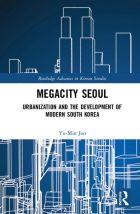Megacity Seoul: Urbanization and the Development of Modern South Korea

Asia is urbanizing faster than Europe and North America did in the past, and will continue to have the majority of the world’s megacities (urban agglomeration areas with a population of over 10 million). Seoul is one of the largest of these, having shot up from a population of 2.4 million in 1960 to 10 million in 1990.
Megacity Seoul describes how the city achieved high-income world-city status within half a century, in an effort to share lessons with planners and policymakers in other large cities. As the introduction comments, the book aims “to build an overarching account of Seoul’s rise from the small underdeveloped capital of a rural country into a competitive global megacity that represents one of the major exporters in the world” (page 11). The book focuses on three strands: 1) Seoul’s growth in the context of Korean policy and investment; 2) Korea’s urbanization in the context of the powerful central government; and 3) Korea’s economic development from the 1960s onward.
This historical analysis shows that from the 1960s, Seoul’s top-down urban development focused on flashy megaprojects, real estate, and the massive family-run corporations known as chaebols. Seoul had some other key differences from many other globalizing cities. For one thing, it wasn’t focusing on becoming a global city. With its relatively low inequality and limited foreign migration, it didn’t embrace neoliberal ideology to the extent that certain other low-income postwar cities did. In Yu-Min Joo’s analysis, Seoul was concerned with growth management before global city-building.
Much of this has changed with the democratization of the 1980s, the Asian financial crisis of the 1990s, and the election and re-election of former human rights activist Won-Soon Park as mayor in the 2010s, along with slowing economic growth and population growth more generally. Yu-Min Joo presents Seoul’s current urban strategy as a more people-focused model suitable for spreading around the world, where Mayor Park leads several international city networks and is savvy about Seoul’s image on the global stage. Under this leadership, Seoul is no longer exporting mainly the electronics and cars produced by chaebols. It’s also exporting the expertise gained by the city itself over the past few decades, like the smart card readers introduced in the mass transit of Ulaanbaatar, Mongolia. That is, “instead of trying to attract global capital to Seoul, the strategy is now about actively exporting “Seoul” abroad” (page 113). It’s an interesting development in the story of a city that has changed with dizzying speed, and is now seeking to leverage its own story.
Further reading:
Ha, Seong-Kyu (2004), “Housing poverty and the role of urban governance in Korea”, Environment and Urbanization Vol 16, No 1, pages 139–153, available at https://journals.sagepub.com/doi/pdf/10.1177/095624780401600112.
Mullins, Paul D (2017), “The ubiquitous-eco-city of Songdo: an urban systems perspective on South Korea's green city approach”, Urban Planning Vol 2, No 2, available at https://www.cogitatiopress.com/urbanplanning/article/view/933.
Shin, Hyun Bang (2008), “Living on the edge: financing post-displacement housing in urban redevelopment projects in Seoul”, Environment and Urbanization Vol 20, No 2, pages 411–426, available at https://journals.sagepub.com/doi/pdf/10.1177/0956247808096120.
Book note prepared by Christine Ro
Search the Book notes database
Our Book notes database contains details and summaries of all the publications included in Book notes since 1993 - with details on how to obtain/download.
Use the search form above, or visit the Book notes landing page for more options and latest content.
For a searchable database for papers in Environment and Urbanization, go to http://eau.sagepub.com/

